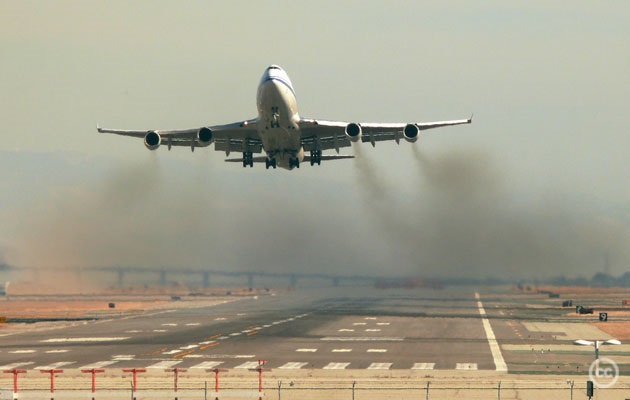11 Dec 2024

Tired Earth
By The Editorial Board

Airplanes could generate 43 gigatonnes of planet-warming pollution through 2050, consuming almost 5 percent of the world’s remaining carbon budget, according to a new Center report.
Aircraft emit staggering amounts of CO2, the most prevalent manmade greenhouse gas. In fact they currently account for some 11 percent of CO2 emissions from U.S. transportation sources and 3 percent of the United States’ total CO2 emissions. All told, the United States is responsible for nearly half of worldwide CO2 emissions from aircraft.
In addition to CO2, aircraft emit nitrogen oxides, known as NOx, which contribute to the formation of ozone, another greenhouse gas. Emissions of NOx at high altitudes result in greater concentrations of ozone than ground-level emissions. Aircraft also emit water vapor at high altitudes, creating condensation trails or “contrails" — visible cloud lines that form in cold, humid atmospheres and contribute to the warming impacts of aircraft emissions. The persistent formation of contrails is associated with increased cirrus cloud cover, which also warms the Earth’s surface. Aircrafts’ high-altitude emissions have a greater global warming impact than they would if the emissions were released at ground level.
Alarmingly, aircraft emissions are expected to more than triple by mid-century. But the Center is working to make sure that prediction doesn’t come true: In December 2007 we joined with states, regional governments and other conservation groups to petition the U.S. Environmental Protection Agency to address the effects of aircraft pollution under the Clean Air Act. The agency continued to drag its feet on the issue, so in June 2010 the Center and allies sued the agency for its failure to address global warming pollution from aircraft, ships and nonroad vehicles. The next year a court ruled that the EPA must formally determine whether greenhouse gas pollution from aircraft endangers human health and welfare. When the agency still hadn't done so nearly three years later, in August 2014 the Center and allies filed a notice of intent to sue it over its failure to reduce global warming pollution from aircraft engines. The next month the EPA announced the beginning of a domestic rulemaking process to determine whether the fast-growing carbon emissions from American aircraft endanger public health and welfare.
In June 2015 the EPA finally released a draft finding that greenhouse gas pollution from America’s aircraft fleet does harm the climate and endanger human health and welfare. But the agency also considered handing off responsibility for airplane emissions to a secretive international aviation organization that, for the past 18 years, has refused to curb aircraft-induced global warming. That agency is now debating setting aviation CO2 emissions standards in 2016, but the standards under consideration are woefully insufficient. By as late as 2030, they would likely affect just 5 percent of aircraft — and even then would do next to nothing to lower the industry’s steeply rising emission curve.
The EPA does not have to adopt do-nothing international standards. It has powerful tools: The U.S. Clean Air Act is designed to force the implementation of technological and operational innovation that prevents or reduces carbon pollution. This means adopting operational measures to minimize fuel use and reduce emissions from aircraft; requiring the use of lighter, more efficient airplanes; and producing and using cleaner jet fuels. A recent International Council on Clean Transportation report found that some of the top 20 transatlantic air carriers can drive down emissions by as much as 51 percent using existing technology and operational improvements, and still remain competitive with their better-performing peers.
Finally, in July 2016 — after nine years of delay — the EPA officially acknowledged in a so-called “endangerment finding” that planet-warming pollution from airplanes disrupts the climate and endangers human welfare. But the agency failed to move forward on rules to actually reduce aircraft emissions. The Center's work to reduce U.S. airplane emissions continues.
Achieving meaningful global action is also critical. That’s why the we urged U.S. climate negotiators to support strong airplane pollution rules in the Paris climate treaty and performed a thorough analysis of the worldwide impacts of pollution from the aircraft sector.
Comment